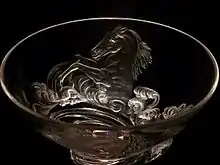Glass engraving
Glass engraving is a form of decorative glasswork that involves engraving a glass surface or object. It is distinct from glass art in the narrow sense, which refers to moulding and blowing glass, and from glass etching which uses acidic, caustic, or abrasive substances to achieve artistic effects. Some artists may combine two or more techniques. There are several different types of glass engraving. It has been practiced since ancient times, including Roman glass.

Glass engraving is considered by many to be a dying art form. While this is far from accurate it is certainly a form that is in decline. Despite this, there are still many glass engravers who are producing bold, dynamic and aesthetically challenging artworks.
The UK currently has a Guild of Glass engravers based in London and lists a number of glass artists as members, including some overseas artists such as Ronald Pennell. It has an online gallery of members' works with contact details for commissions and classes for people who want to learn about this art. A general exhibition is held every two years. The most recent ones have been held at the Fitzwilliam Museum[1] in Cambridge 2010.
The Czech Republic, having produced many world class glass artists, hosts a conference aimed specifically at glass engravers every two years.
Types
Glass engraving encompasses a variety of techniques, including intaglio work, with images and inscriptions cut into the surface of the glass through abrasion. Glass engraving tools are typically small abrasive wheels and drills, with small lathes often used. Engraving wheels are traditionally made of copper, with a linseed oil and fine emery powder mixture used as an abrasive.
.jpg.webp)
Other forms of engraving are "stipple" and "drypoint" in which the surface of the glass is abraded with the use of small diamond tipped burrs. The scratches and small dots made in this method can, in the hands of a skilled artist, be used to produce images of astonishing clarity and detail. A notable practitioners of this form is the late Lawrence Whistler who began a revival in England.
Sandblasting is another technique used in glass engraving. Abrasive is sprayed through a sandblasting gun on to glass which is masked up by a piece of stencil in order to produce inscriptions.
See also
References
| Wikimedia Commons has media related to Glass engraving. |